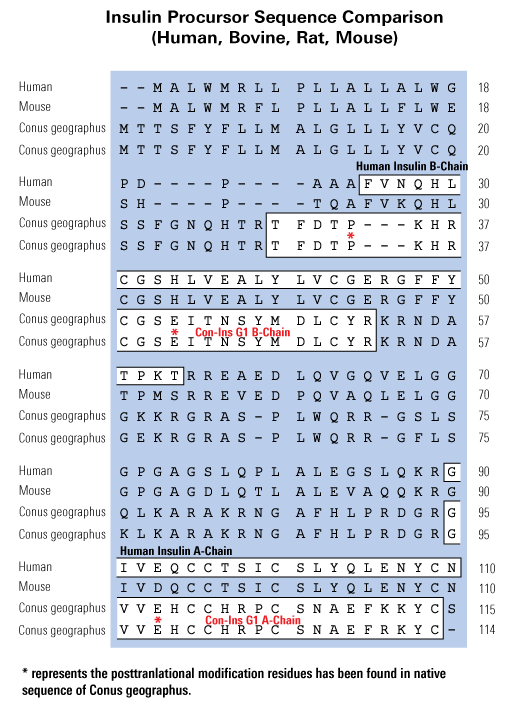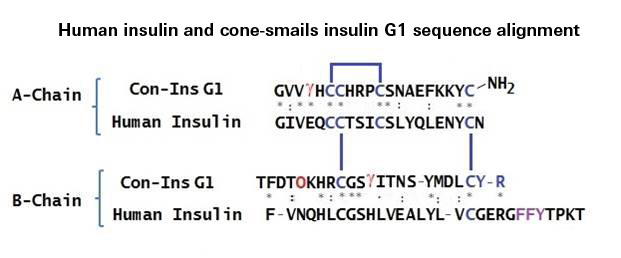Catalog # |
Size |
Price |
|
|---|---|---|---|
| 036-45 | 100 µg | $436 |
 )
)
|
Arg-Leu-Cys-Ser-Arg-Asn-Leu-Ser-Asp-Ala-Leu-Tyr-Leu-Val-Cys-Arg-Glu-Arg-Gly-Tyr-Asn-Ser-Tyr-Ser-Tyr-Ser-Asp-Asp-Asp-Glu-Thr-Gln-Val-Asp-Asn-Gly-Pro-Gly-Leu-Val-Asp-Glu-Cys-Cys-Tyr-His-Ala-Cys-Ser-Tyr-Glu-Gln-Leu-Glu-Arg-Tyr-Cys-Lys-NH2
|
|
Disulfide bridge(s): Cys1-Cys4, Cys2-Cys6 & Cys3-Cys5 |
| 6763.37 | |
|
| ≥ 95% |
|
|
Store peptide in DRY form at 0-5°C.
For best results and reproducibility, rehydrate peptide just before use. Do not attempt to weigh out smaller portions. Do not refreeze any unused portions |
|
| White powder |
|
| Each vial contains 100μg of NET peptide |


The discovery of insulin and its use for the treatment of diabetes is undoubtedly one of the true successes of modern medicine. Injectable insulin would prove the first effective treatment for a previously incurable and usually fatal disease. Soon after however, the powerful effects of insulin overdose would be reported, and subsequently exploited for dubious medical and sometimes nefarious purposes. In this article we describe the discovery that certain venomous marine snails of the genus Conus also exploit the powerful effects of insulin overdose, employing it as a weapon for prey capture.
Robinson SD, Safavi-hemami H. Toxicon. 2016;123:56-61.
Insulins in the venom of certain fish-hunting cone snails facilitate prey capture by rapidly inducing hypoglycemic shock. One such insulin, Conus geographus G1 (Con-Ins G1), is the smallest known insulin found in nature and lacks the C-terminal segment of the B chain that, in humaninsulin, mediates engagement of the insulin receptor and assembly of the hormone's hexameric storage form. Removal of this segment (residues B23-B30) in human insulin results in substantial loss of receptor affinity. Here, we found that Con-Ins G1 is monomeric, strongly binds the human insulin receptor and activates receptor signaling. Con-Ins G1 thus is a naturally occurring B-chain-minimized mimetic of human insulin. Our crystal structure of Con-Ins G1 reveals a tertiary structure highly similar to that of human insulin and indicates how Con-Ins G1's lack of an equivalent to the key receptor-engaging residue PheB24 is mitigated. These findings may facilitate efforts to design ultrarapid-acting therapeutic insulins.
Menting JG, Gajewiak J, Macraild CA, et al. Nat Struct Mol Biol. 2016;23(10):916-920.
A specialized insulin was recently found in the venom of a fish-hunting cone snail, Conus geographus Here we show that many worm-hunting and snail-hunting cones also express venom insulins, and that this novel gene family has diversified explosively. Cone snails express a highly conserved insulin in their nerve ring; presumably this conventional signaling insulin is finely tuned to the Conus insulin receptor, which also evolves very slowly. By contrast, the venom insulins diverge rapidly, apparently in response to biotic interactions with prey and also possibly the cones' own predators and competitors. Thus, the inwardly directed signaling insulins appear to experience predominantly purifying selection to target an internal receptor that seldom changes, while the outwardly directed venom insulins frequently experience directional selection to target heterospecific insulin receptors in a changing mix of prey, predators and competitors. Prey insulin receptors may often be constrained in ways that prevent their evolutionary escape from targeted venom insulins, if amino-acid substitutions that result in escape also degrade the receptor's signaling functions
Safavi-hemami H, Lu A, Li Q, et al. Mol Biol Evol. 2016;33(11):2924-2934.
The venoms of cone snails (genus Conus) are remarkably complex, consisting of hundreds of typically short, disulfide-rich peptides termed conotoxins. These peptides have diverse pharmacological targets, with injection of venom eliciting a range of physiological responses, including sedation, paralysis and sensory overload. Most conotoxins target the prey's nervous system but evidence of venom peptides targeting neuroendocrine processes is emerging. Examples include vasopressin, RFamide neuropeptides and recently also insulin. To investigate the diversity of hormone/neuropeptide-like molecules in the venoms of cone snails we systematically mined the venom gland transcriptomes of several cone snail species and examined secreted venom peptides in dissected and injected venom of the Australian cone snail Conus victoriae. Using this approach we identified several novel hormone/neuropeptide-like toxins, including peptides similar to the bee brain hormone prohormone-4, the mollusc ganglia neuropeptide elevenin, and thyrostimulin, a member of the glycoprotein hormone family, and confirmed the presence of insulin. We confirmed that at least two of these peptides are not only expressed in the venom gland but also form part of the injected venom cocktail, unambiguously demonstrating their role in envenomation. Our findings suggest that hormone/neuropeptide-like toxins are a diverse and integral part of the complex envenomation strategy of Conus. Exploration of this group of venom components offers an exciting new avenue for the discovery of novel pharmacological tools and drug candidates, complementary to conotoxins.
Robinson SD, Li Q, Bandyopadhyay PK, et al. Gen Comp Endocrinol. 2015;
More than 100 species of venomous cone snails (genus Conus) are highly effective predators of fish. The vast majority of venom components identified and functionally characterized to date are neurotoxins specifically targeted to receptors, ion channels, and transporters in the nervous system of prey, predators, or competitors. Here we describe a venom component targeting energy metabolism, a radically different mechanism. Two fish-hunting cone snails, Conus geographus and Conus tulipa, have evolved specialized insulins that are expressed as major components of their venoms. These insulins are distinctive in having much greater similarity to fish insulins than to the molluscan hormone and are unique in that posttranslational modifications characteristic of conotoxins (hydroxyproline, γ-carboxyglutamate) are present. When injected into fish, the venominsulin elicits hypoglycemic shock, a condition characterized by dangerously low blood glucose. Our evidence suggests that insulin is specifically used as a weapon for prey capture by a subset of fish-hunting cone snails that use a net strategy to capture prey. Insulin appears to be a component of the nirvana cabal, a toxin combination in these venoms that is released into the water to disorient schools of small fish, making them easier to engulf with the snail's distended false mouth, which functions as a net. If an entire school of fish simultaneously experiences hypoglycemic shock, this should directly facilitate capture by the predatory snail.
Safavi-hemami H, Gajewiak J, Karanth S, et al. Proc Natl Acad Sci USA. 2015;112(6):1743-8.
No References
Social Network Confirmation